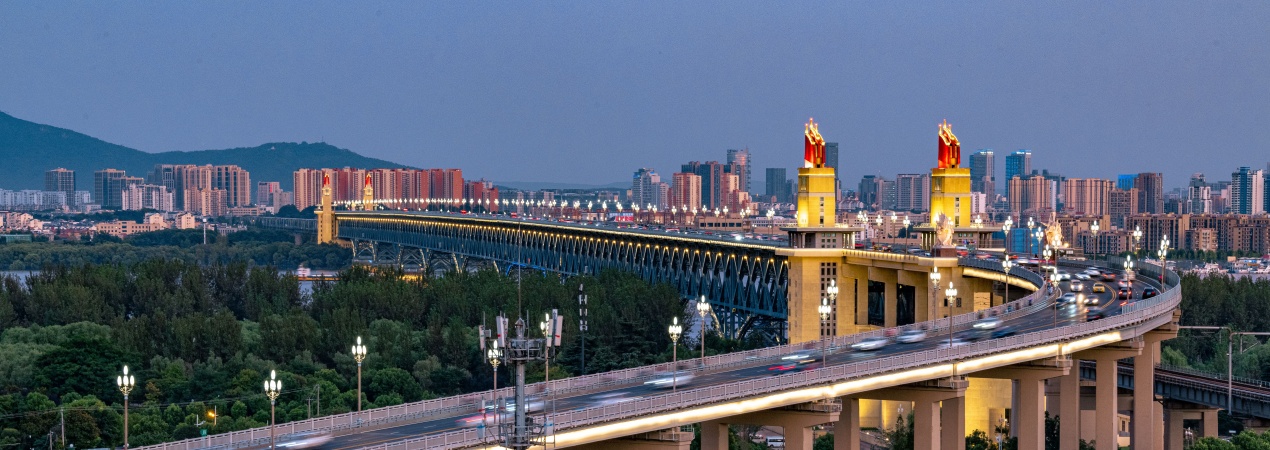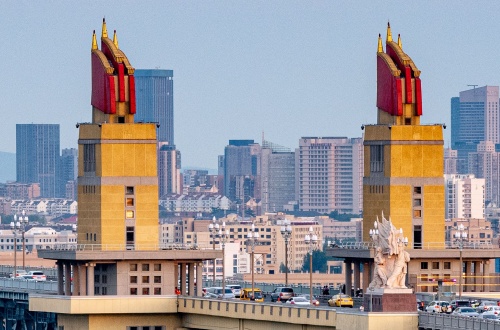Nanjing Yangtze River Bridge

Between Xiaguan (Gulou District) and Qiaobei (Pukou District) in Nanjing, Jiangsu, stands the Nanjing Yangtze River Bridge. China itself designed and built the first double-deck Yangtze bridge, for both trains and cars. It matters a lot in China's and the world's bridge history, a key achievement in China's economic development and a major milestone in its bridge building.
- Chinese name:南京长江大桥Nán Jīng Cháng Jiāng Dà Qiáo
- Recommended Duration: 1 hours
- Entrance Fee: Free
- Opening Hours: All day
- Best time to visit: September to November
- Address: Xiaguan (Gulou District) and Qiaobei (Pukou District), Nanjing, Jiangsu
- How to get there: Take the Metro Line S8 to North Changjiang Bridge Station
Highlights of Nanjing Yangtze River Bridge
The Bridgehead Fortress Sculptures
 The Bridgehead Fortress Sculptures
The Bridgehead Fortress SculpturesFortress-style bridgeheads, iconic of the Nanjing Yangtze River Bridge, stand at both ends. The big ones, around 70 meters high, have steel Three Red Flags on top—they stand for the General Line, the Great Leap Forward, and the People's Communes. Large slogans like "Long Live the Great Unity of the People of the World!" are on their fronts. Smaller fortresses have concrete statues of workers, peasants, soldiers, students, and merchants, with firm looks and lifelike clothes.
These sculptures have shown the spirit of their time since the bridge was finished in 1968, showing China's pride in building on its own. Now, the bridgeheads are a must-see; visitors can feel history's weight here. At night, golden lights light them up, and the red flag sculptures glow solemnly against the river's shimmer.
The Cast-Iron Relief Gallery
202 cast-iron relief panels line both sides of the bridge, forming an open-air art gallery almost 1.6 kilometers long. 98 of them have hollowed-out sunflowers, standing for the search for light; another 98 show scenes like Beijing Railway Station and Daqing Oilfield, displaying New China's achievements. The last six focus on workers, peasants and soldiers, with gears and wheat ears—they stress labor's dignity.
Made with bold, lively lines and strong depth, these iron reliefs were cast and put up when the bridge opened in 1968. Now, walking the pedestrian path, visitors can follow each panel's fine details, feeling the era's passion. Trains rumble below, river breeze blows above—this mix of senses makes the gallery a deep way to grasp the bridge's cultural meaning.
Nanbao Park
At the bridge's southern end, Nanbao Park lets visitors take old elevators up to the fortress observation deck for about 15 yuan, with a full view of the Yangtze River and the bridge's double decks. A new glass walkway circles the viewing area for free; from its clear platforms, you can see the shining Jinchuan River below and the steel giant stretching across the sky—great for one-of-a-kind photos.
The park has been a key tourist spot since the bridge was finished. Now, these facilities let visitors experience the bridge from many angles. Take a ferry from Zhongshan Wharf too, which lets you look up from the river. Together, they show the engineering wonder of "making a natural gap a road."
Educational Value
The Nanjing Yangtze River Bridge, a transport hub linking the river's north and south banks, broke the Yangtze's barriers to regional growth when completed, greatly changing Nanjing's and the Yangtze River Delta's economic scene. It still handles busy passenger and freight transport today. This project, "benefiting both present and future," has engineering value. It helps people see infrastructure's long-term importance for national development and understand the meaning of "hard work brings national prosperity."
Activities to do at Nanjing Yangtze River Bridge
Checking in at the glass walkway: The glass walkway in Nanbao Park is a popular spot. Standing on the transparent viewing platform, you can look down at huge ten-thousand-ton ships passing below, feeling the bridge's grandeur and the Yangtze's power. You can also take photos here with your back to the bridge, bridgeheads or the river—unique shots day and night.
Drop us a line and we'll connect you with the top China expert in no time!